Before explaining why I reject brainstorming, I must first talk about the two forms of imagination: synthetic, and true.
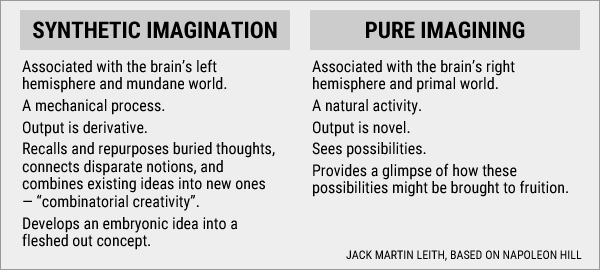
Inspired by Napoleon Hill, whose original descriptions can be viewed here: Synthetic imagination and pure imagining
Producing ideas through synthetic imagination
Sometimes a modest idea is all that’s required. The answer lies inside you and it’s just a matter of bringing it to the surface by means of the faculty Napoleon Hill named synthetic (mechanical, laboured, derivative) imagination. I have adopted this term and named its counterpart true (organic, spontaneous, inspired) imagination.
Idea generation, or ideation if you prefer — I strongly dislike both terms — is founded on two articles of faith:
![]() It must be undertaken in a group.
It must be undertaken in a group.
![]() It must employ a diverge-converge approach.
It must employ a diverge-converge approach.
In the organisational realm, brainstorming is the method of choice for the ‘diverge’ component. A brainstorming session is easy to run and it’s a high octane group activity that participants enjoy.
I’m not using the word brainstorming to mean a bunch of people sitting in a meeting room tossing out ideas willy-nilly and arguing about which one to pursue, as seen in reality TV shows such as The Apprentice and Gordon Ramsay’s Future Food Stars.
Rather, I’m referring to the rules-based process invented in the late 1930s by Alex Osborn.
Osborn co-founded the US advertising agency that became Batten, Barton, Durstine & Osborn (BBDO), later establishing the Creative Education Foundation and developing the popular Osborn-Parnes Creative Problem Solving Process with Sid Parnes.
At a brainstorming session, participants are instructed to follow one of the many versions of Osborn’s rules.
These are the rules laid down by Osborn in his influential 1953 book Applied Imagination:
- Criticism is ruled out. Adverse judgment of ideas must be withheld until later.
- “Freewheeling” is welcomed. The wilder the idea the better: it is easier to tame down than think up.
- Quantity is wanted. The greater the number of ideas, the more the likelihood of useful ideas.
- Combination and improvement are sought. Suggest how ideas of others can be turned into better ideas or how two or more ideas can be joined.
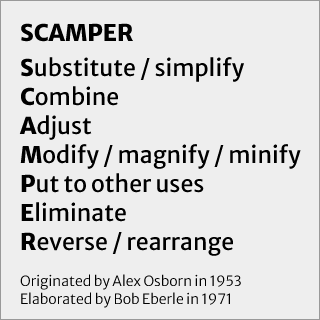
Read more about SCAMPER and its origins in the article Reappreciating Applied Imagination: Osborn’s lost SCAMPER, by GK VanPatter, co-founder of design firm Humantific
Participants in a brainstorming session recall and repurpose buried thoughts, connect disparate notions and combine existing ideas into new ones — a process known as combinatorial creativity.When idea generation work (“diverge”) is complete, options are evaluated and the most promising one is selected (“converge”) for further development and eventual realisation.In a brainstorm the default method of finding ideas is by free association. The group having been given the problem or challenge statement, seek ideas in a spontaneous, accidental fashion through internal ‘semantic networks’ of association connecting the challenge to other words, phrases, concepts and experiences they can recall from memory.
Kevin Byron, Creative reflections on brainstorming (pdf) London Review of Education, Vol. 10, No. 2, July 2012, 201–213
Brainstorming issues identified by researchers
Production blocking individuals must wait for their turn to speak, which disrupts their thought process and reduces idea generation.
Collaborative fixation Exposure to others’ ideas can lead participants to fixate on certain concepts, limiting creativity and diversity of thought.
Evaluation apprehension Fear of negative judgment from peers may cause individuals to self-censor, preventing them from sharing unconventional or risky ideas.
Free-writing 1 While intended to encourage idea generation, unstructured free-writing can lead to aimless or redundant contributions, making it less effective than structured brainstorming.
Personality characteristics Extroverts tend to contribute more in group discussions, while introverts may hold back, leading to an imbalance in idea sharing.
Illusion of group productivity Participants may overestimate the effectiveness of group brainstorming, believing they are generating more ideas than they actually are.
Social matching Individuals tend to match their effort to the perceived productivity level of the group, which can limit overall performance if others contribute less.
Regression to the mean Exceptional ideas may be diluted by more average contributions, leading to less creative outcomes.
Social loafing Some members may contribute less effort, assuming others will pick up the slack, which reduces overall group output.
Social anxiety Nervousness about speaking in a group can hinder participation, particularly for those who fear judgment or lack confidence in their ideas.
1. Although free-writing and Osborn-style brainstorming are separate methods, the widespread practice in which participants submit their ideas on Post-it® Notes could be considered a form of free-writing.
Further reading![]() Research studies and scholarly texts (below)
Research studies and scholarly texts (below)
Five reasons for rejecting brainstorming
1. Idea conception is an individual act
An idea is conceived in the mind of an individual, not in some fanciful group mind. Elaborating the bare bones idea may be a collaborative process, but conception is a solo act.
Many music composers, graphic designers, journalists and other creative people work alone. This website is all my own work, from writing the words and making the graphics to handling all the technical WordPress stuff. I’m creating alone at this very moment, typing sentences that didn’t exist previously.
View a collection of quotes from songwriters, authors and others who create alone
2. The emphasis on quantity is misguided
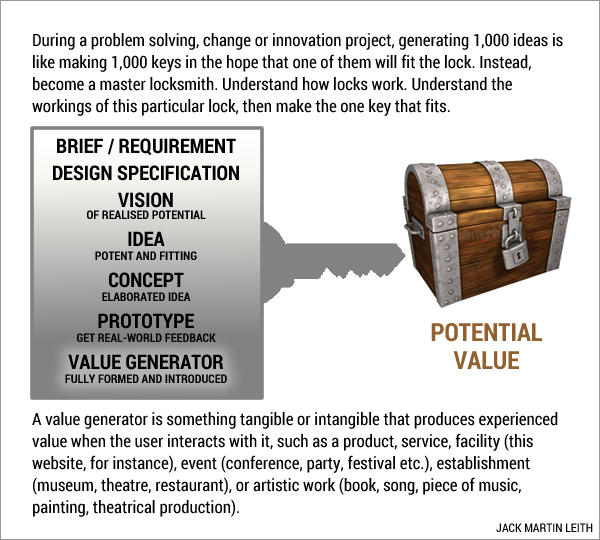
The idea generation dictum quantity breeds quality is based on the assumption that if you produce a sufficiently large number of ideas, the one that’s needed will be among them. This is rather like making a lot of different keys in the hope that one of them will fit the lock, rather than knowing how locks work, understanding the workings of this specific lock and making the one key that fits. Watch the Lock Picking Lawyer do this in just five minutes:
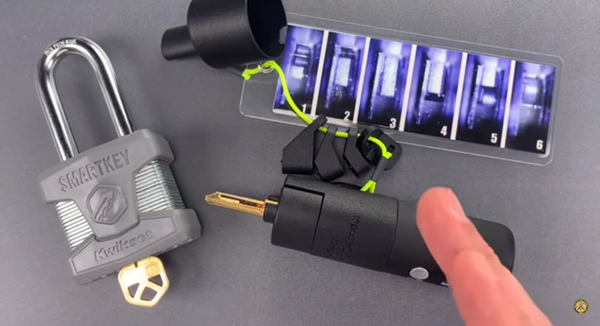
Watch the video
If there is one simple recommendation that can be distilled from my results, it is this: Creativity practitioners and researchers would do well to worry less about quantity, and more about quality – before, during, and after idea generation.
From quantity to quality: Cognitive, motivational and social aspects of creative idea generation and selection (pdf), doctoral dissertation submitted by Eric Fulco Rietzschel
3. Pure imagining is not deployed
Brainstorming and other diverge-converge methods lean heavily on the brain’s left hemisphere and synthetic imagination, employing recall, word association, analogy, repurposing, and combinatorial creativity, where existing ideas are combined to form a new one.
Ideas produced by means of synthetic imagination may eventually yield some degree of value, but they are often mediocre or derivative with limited value generation potential.
4. Discussion is not permitted
This brainstorming rule persists even though there is evidence that discussion can be beneficial.
See for example Reflection enhances creativity: Beneficial effects of idea evaluation on idea generation in the research section below.
5. Extroverts dominate
The format of a brainstorming session makes it hard for introverts, autistic people, other neurodivergent members of society and the socially anxious to contribute their ideas.
Pure imagining must be deployed if you need high potential ideas
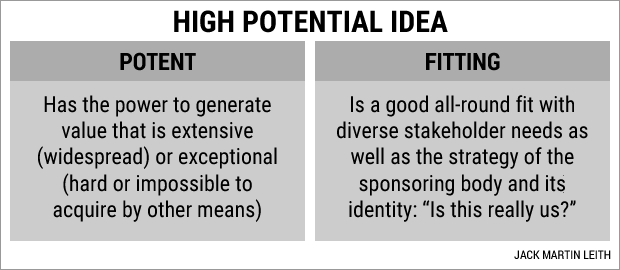
Synthetic imagination is sufficient for producing a modest idea. But when a high potential idea is required, one that is potent (showing extensive or exceptional value generation potential) and fitting (the key fits the lock), the answer is unlikely to reside inside you, waiting to be unearthed. Instead of working outwards from your inner world, you must start in the outside world and work inwards.
This means immersing yourself in the demands and dynamics of the project (either through Readiness work or by other means), entering primal world and inviting pure imagining to present you with a possibility for enriching your world with value, meaning and joy,
The imagined scenario is then represented as a vision of realised potential. This is a depiction — an actual picture accompanied by a vivid and compelling synopsis — of how the world will look, sound and feel when the new creation exists in its finished state (even though you do not yet know what form it will take) and its value generation potential is being realised without constraint.
In a group setting, work carried out up to this point should be sufficient for members to summon from their imaginations a potent idea for a new creation (product, service, enterprise, establishment, theatrical production etc.) with the potential to generate the imagined value, meaning and joy for customers or users and other beneficiaries.
Group members’ ideas can then be captured, discussed and enhanced by means of the Idea-to-Concept Method.
The output will be a single idea, both potent and fitting, that is ready to be developed into a new something or other, which will generate the imagined value, meaning and joy further down the track.
Some research studies and scholarly texts
Creative reflections on brainstorming (pdf) by Kevin Byron, London Review of Education, Vol. 10, No. 2, July 2012, 201–213
Does group participation when using brainstorming facilitate or inhibit creative thinking? (often referred to as the Yale study; abstract only — no pdf available) by Donald W. Taylor, Paul C. Berry and Clifford H. Block, Administrative Science Quarterly, Vol. 3, No. 1 (June 1958), pp. 23-47
Does Quantity Generate Quality? Testing the Fundamental Principle of Brainstorming (pdf) by Alfredo Muñoz Adánez (2005), The Spanish Journal of Psychology 8(2):215-20
Effects of Quantity and Quality Instructions on Brainstorming (pdf) by Paul B. Paulus, Nicholas W. Kohn, and Lauren E. Arditti, March 2011, The Journal of Creative Behavior 45(1)
Enhancing Ideational Creativity in Groups by Paul B. Paulus, University of Texas at Arlington, and Vincent R. Brown, September 2003, in book: Group Creativity (pp.110-136)
From quantity to quality (pdf) by Eric Fulco Rietzschel, PhD dissertation
The liberating role of conflict in group creativity: A study in two countries by Charlan J. Nemeth, Bernard Personnaz, Marie Personnaz, and Jack A Goncalo (2004), University of Illinois, Urbana-Champaign. European Journal of Social Psychology 34(4):365-374
Making Group Brainstorming More Effective: Recommendations from an Associative Memory Perspective (pdf) by Vincent R. Brown, MITRE, and Paul B. Paulus, University of Texas at Arlington, December 2002, Current Directions in Psychological Science 11(6):208-212
Productivity Loss in Brainstorming Groups: A Meta-Analytic Integration (pdf) by Brian Mullen , Craig Johnson and Eduardo Salas, Basic and Applied Social Psychology, Volume 12, 1991 – Issue 1
Productivity Loss In Brainstorming Groups: Toward the Solution of a Riddle (pdf) by Michael Diehl and Wolfgang Stroebe, September 1987, Journal of Personality and Social Psychology 53(3):497-509
Quality Conformity and Conflict: Questioning the Assumptions of Osborn’s Brainstorming Technique (pdf) by Olga Goldenberg and Jennifer Wiley, University of Illinois at Chicago, The Journal of Problem Solving, volume 3, no. 2 (Winter 2011)
Reflection enhances creativity: Beneficial effects of idea evaluation on idea generation (pdf) by Ning Hao, Yixuan Ku, Meigui Liu, Yi Hu, Mark Bodner, Roland H. Grabner, and Andreas Fink, Brain and Cognition, Volume 103, March 2016, Pages 30-37
A Review of Brainstorming Research: Six Critical Issues for Inquiry (pdf) by Scott G. Isaksen, Creativity Research Unit, Creative Problem Solving Group Inc., Buffalo, New York, USA, June 1998
The ‘Rules’ of Brainstorming: An Impediment to Creativity? (text) by Matthew Feinberg and Charlan Nemeth (2008), Institute for Research on Labor and Employment Working Paper Series (University of California, Berkeley) Paper iirwps-167-08
So you think you know how to Brainstorm? Part 1 | Part 2 | by Andy Wilkins (Perspectiv), Ranjna S. Narayan (National Grid), and Scott G. Isaksen (Creative Problem Solving Group)
Continue reading
External sources
Ten Dots Not Connected: Appreciating Alex Osborn, by GK VanPatter, co-founder of Humantific
This website
A collection of quotes about pure imagining at work
The seven kinds of now-to-new work
Readiness work sets the now-to-new project in motion
Should idea conception be left to specialists?
The three now-to-new action modes — Part 1
Slideshow: Transcend the mundane, create the new and enrich the world
Search the site
Not case sensitive. Do not to hit return.